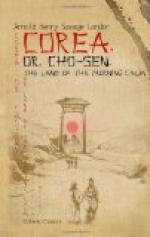A few yards from the signal station, though still on Mount Nanzam, there is a picturesque red joss-house with a shrine in close proximity to it. The story goes—and the women of Cho-sen find it convenient to believe it—that a visit to this particular joss-house has the wonderful effect of making sterile women prolific. A few strings of cash and a night’s rest at the temple—preceded, if I remember rightly, by prayers—constitute sufficient service to satisfy the family duties, and I was certainly told that in many cases the oracle worked so well that in due time the chin-chins got rewarded with the birth of babies. I may mention incidentally that the caretaker of the joss-house was a strong, healthy, powerful man.
As we are now on a splendid point of vantage for a bird’s-eye view of the town we may as well take a glance over it.
Very prominent before us, after the large enclosure of the royal Palace, are the foreign buildings, such as the Japanese Legation on a smaller hill at the foot of Nanzam, and overlooking the large Japanese settlement; the abode of the Chinese Minister resident, with its numerous buildings around it; the British Consulate with its new red brick house in course of construction; and, by the side of the last mentioned, the compounds of the American and Russian legations. Farther on, nearer the royal Palace, the German flag may be seen surmounting the German Consulate, which is situated in an enclosure containing several Corean houses which have been reduced a l’ Europeenne and made very comfortable. Then the large house with a glass front is the one now inhabited by the Vice-Minister for Home Affairs, but the grounds surrounding this are very restricted. A nunnery and a few houses of missionaries also stand prominent, mostly in the neighbourhood of the Japanese settlement.
The Japanese settlement, into which we will now descend, is noteworthy for the activity and commercial enterprise shown by the subjects of the Mikado. It is remarkable, also, to notice the curious co-existence of sense and nonsense in the Jap’s adoption of foreign customs. For instance, you see the generality of them dressed in European clothes, but nevertheless still sticking to the ancient custom of removing their boots on entering a house; a delightful practice, I agree, in Japan, where the climate is mild, but not in a country like Corea, where you have an average of sixty degrees of frost. Then again, the Japanese houses, the outer walls of which consist of tissue paper, seem hardly suited to such a climate as that of Corea. It is really comical to watch them as they squat in a body round a brass brasier, shivering and blue with cold, with thin flat faces and curved backs; reminding one very much of the large family of quadrumans at the Zoo on a cold day. Nevertheless, they are perfectly happy, though many die of pleurisy, consumption, and cold in the chest.
The Japanese women dress, of course, in their national kimonos, and just as it is in Japan the fashion to show a little of the chest under the throat, so in Cho-sen the same custom is adopted; with the result that many are carried off by bronchitis to the next world.




